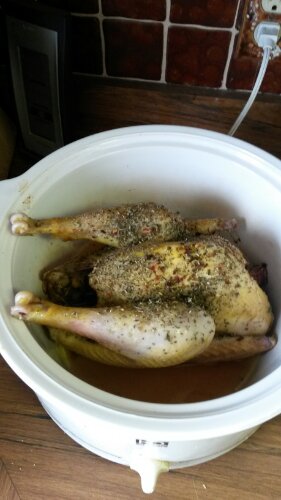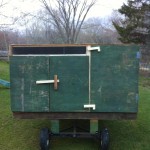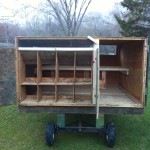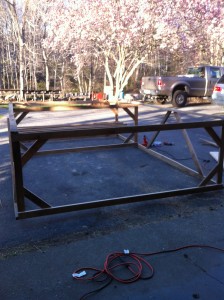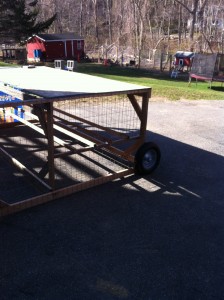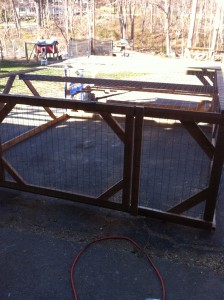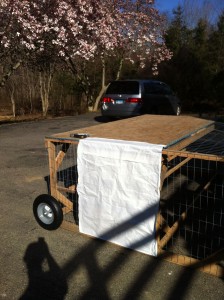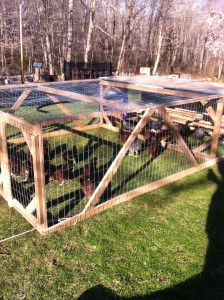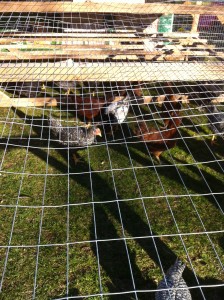This morning we processed 8 roosters being raised for meat. And tonight we will eat the one Vicki named Butter. She was very excited to finally eat a leg that she had been watching grow since May.
Tag Archives: chicken
How to fully use a rabbit
We enjoy raising rabbits as a meat product. Unfortunately, it’s not very cheap to raise a rabbit. It actually costs about as much to raise a rabbit for meat as raising a chicken (and takes about as much time). However, because of the skin, head, feet, etc, the live to meat conversion is about 50% but on a chicken it is about 65-70% (for the heritage breeds we raise). This means we have to charge more per pound for rabbits. If only we could use all those other pieces and distribute the cost, making the meat cheaper. Finally, we have been successful at figuring out how!
We are now selling Raw Dog Food products! Specifically, we are packaging the heads and feet for the raw dog food community. It turns out, these are used as treats for dogs. In fact, I discovered websites selling 1/2 lbs of rabbit feet for $10! We have also developed some outlets for the rabbit pelts.
The bottom line is, we have a new customer base and the use of previously discarded parts means we can LOWER our prices for rabbit meat. These days almost nothing gets cheaper, but we found a way to do it. We also improved our packaging of the rabbits so they are less likely to get freezer burn. Now is a great time to try rabbit!
2012 review, 2013 plans
First, Thank You to everyone who supported Sawyer Family Farm in 2012!
Last year was marked by significant growth and trying new things on the farm and we learned a lot. When we started our farm, it was with the intent to provide healthier food for our family, that we could trust was free of antibiotics, artificial hormones, injected juices, and all the other things that we don’t know about in the mainstream food supply. We are well on our way to achieving that goal. Frequently last summer, we were able to serve entire meals with items produced exclusively on our farm: meat, vegetables, and dairy products. We enjoy raising the animals, however, it is a lot of work (just ask our farm sitter who experienced the life for 10 days while we were gone at Christmas)! A frequent conversation starter at our house is “What do we enjoy, what do make money at, and what isn’t worth the money.”
So, here is a breakdown across the areas we tried out in 2012 and some of our 2013 plans.
Eggs: There is a constant demand for our eggs. We love the idea of having a cooler at the end of our driveway to sell fresh eggs to local neighbors, however, after losing around $100 in coolers, eggs, and money, we had to stop. We have been providing eggs to other groups such as Wesleyan University Food Co-op and for sale on CT Farm Fresh Express, however, our local customers come first, so if you still want our fresh eggs, give us a call. 2013: We will continue to have fresh eggs available, however, we will not expand our laying flock. NOTE: we are getting ready for chick hatching season soon, so eggs may not be quite as available as we set them aside for hatching.
Meat Chickens: Wow. I never expected so much demand for the meat chickens. We ended up selling almost half of what we planning to keep for ourselves, but that is ok, because we have been eating more rabbits. In 2012, we tried Freedom Rangers as a meat chicken and also raised more heritage roosters. While we didn’t raise any Cornish Cross, we did process them on a number of occasions for another farm. While the Cornish Cross get bigger, have more breast meat, and are ready in half the time, we have decided they WILL NOT be raised on our farm. Additionally, we will not raise the Freedom Rangers again. We have decided that we prefer chickens that move around, scratch the grass, and act like chickens, even if that means it takes longer to raise them at a slightly higher cost.
2013: We will still raise some chickens as meat birds. However, based on the time it takes to process when they are all ready (and our extremely busy weekend schedules), we will likely have a very limited number of chickens available for sale. These will be offered to previous customers first.
Chicks: We hatched a lot of chicks in 2012 on a continuous hatching plan. This year, are going to try a very different approach. Stand by for an update on this within the next week.
Turkeys: Turkeys are stupid. That’s all there is too it. While we did get excellent feedback, we haven’t decided if the turkeys are worth the trouble. It was definitely more stressful than I anticipated as we approached Thanksgiving and realized many of the birds were going to be smaller than expected. We haven’t decided what future turkeys will have on the farm, however, we are committed to the heritage breeds if we raise them again.
Rabbits: This has to be one of the more frustrating areas of the farm. The rabbits are easier to care for than the chickens, easier to breed year round, and require less work. However, due to the feed costs, they are more expensive, which I think is negatively impacting our ability to sell more rabbits. Additionally, since rabbit isn’t a mainstream food source in the US, many are reluctant to try it. Rabbits are not going away (in fact we would really like to expand). We have a few ideas about what we might be able to do in order to lower costs for feeding. Stand by for a new project announcement in the near future.
Goats: We love the goats. They are just fun. The human kids enjoyed showing last summer at the North Stonington Fair, and this year, in 4-H, they will show goats a little more. Last summer, we used the milk to drink (a lot), make ice cream, and make soft cheese until we got tired of goat cheese and wine (which takes about 3 months, every evening after the human kids go to bed). Right now we have 9 does that we think are all bred. Kidding season starts in February and continues into early June. We haven’t completely decided on how large our dairy herd will be in the future, however, we do plan to sell a lot of kids (goat version only). Anna has grand plans to make hard cheeses (as soon as I buy or build a press) and soaps. That’s right, we will be selling Goat’s Milk soap and other skin care products in 2013.
Beef: We didn’t do anything with raising beef in 2012. However, we did by half a veal calf from some friends who also raise goats, and the meat was fabulous. We got 40lbs of meat from our half calf. Our plan is, buy a bob calf (male dairy calf) at less than a week old. Switch it over to goat milk and raise it for 2-3 months. The calf will live with the goats and be raised on milk and hay – no grains. We will pre-sell the calves as a whole or half calf and you pick up your meat at the butcher. More info and pricing will be available in the future, however this will be a very limited commodity.
Horses: Anna has been teaching some lessons. She is very good at it, even if she doesn’t believe that herself. At dinner the other night, Alex even stated his favorite riding instructor was his Mom! This year, we expect to continue to expand our horse involvement as the kids are more active in Pony Club and Anna and I try to riding more hunter paces for ourselves. We became dealers for a number of horse care products, primarily as associated with my trimming work. Horses have always been our first passion, and we are always challenged to make time for that as the other activities on the farm grow.
2013 resolutions:
Stay true to heritage breeds.
Continue to find efficiencies on farm.
Reduce reliance on commercial feed.
Have fun.
Freedom Ranger wrap up
This morning, we harvested the remaining Freedom Rangers that we were raising for meat. Here is the summary:
We started with 51 birds. None died from sickness. None suffered broken legs from excessive growth. We lost 6 due to predators (raccoon pulling birds through the side of the chicken tractor at night).
23 were harvested at 10 weeks old and averaged 3.7lbs (mostly roosters)
22 were harvested at 12 weeks old and averaged 3.95lbs (all hens).
The birds consumed 900 lbs of feed.
Therefore, it took 900 lbs of feed to raise 172 lbs of meat for a 5.24:1 conversion.
Average live to package weight was 65%.
29 of the 45 birds were sold and the rest reside in our own freezer.
We also harvested 9 heritage breed roosters this morning that were approximately 4 months old. The average weight was closer to 3.5lbs, the body cavities were smaller, breasts smaller, legs larger, and I suspect the meat will be slightly tougher. Since we cook almost all chickens in the crock pot, that doesn’t matter as much. The biggest difference is the heritage birds are not nearly as nasty as the meat birds.
We are torn about what kind of birds to raise next. Freedom Rangers are off the list. If we are raising meat birds, we might as well do the Cornish cross. However, we don’t really like the meat birds as much as the heritage breeds.
Home grown chickens in the freezer
In April, our Freedom Ranger meat chickens arrived on the farm (read here). Saturday morning, the first group of 23 got processed. Of the original 51, none died due to disease, however, we did lose 6 to predators (probably a raccoon). Here are our observations about the birds:
1. The chickens were just over 10 weeks old and had an average packaged weight of 3.7lbs. This is a little lower than originally hoped for, but was a 67% live to packaged weight conversion. By comparison, a group of cornish cross that I processed for someone else at 8 weeks averaged over 4lbs and had a 75% live to packaged conversion.
2. 45 birds at 10 weeks were consuming 25-30lbs of feed a day. The first 23 that we processed were the larger birds. The remaining 22 birds will be raised another 3 weeks.
3. It took 750 lbs of feed (15 bags) to raise the entire group of birds to the 10 week point. I expect to use another 200-250lbs to raise the remaining birds 3 more weeks. Rough math means that it took about 4.5lbs of feed per lb of meat. By comparison, I have seen numbers more like 2.5-3lbs of feed per lb of meat for the Cornish Cross.
4. Meat birds are disgusting. They poop a lot and sit around a lot more compared to dual purpose birds. From all the discussions with others, I don’t think there was a significant difference between our Freedom Rangers and Cornish Cross birds.
5. While the Freedom Rangers definitely got larger faster than a Dual Purpose rooster (like a Barred Rock), the meat was not necessarily better and the higher feed consumption was a disadvantage.
6. Cornish Cross had fewer feathers, larger breasts, and bigger chest cavities at 8 weeks than our Freedom Rangers had at 10 weeks.
Overall, we have decided that if we raise more pure meat birds, they will be Cornish Cross. Also, even as large as our chicken tractor is, 50 is more than we want in that space. I think we will plan for 25-30 next time.
While we do make a little profit on the birds sold, it is not significant enough to make us want to do chickens full-time.
The Freedom Rangers have arrived!
Today our batch of meat chickens (Freedom Rangers) arrived at the post office and Anna picked them up. The 51 chicks are 2 days old. Since this is our first experience with an actual meat bird, we will be keeping detailed records. They should be ready for harvest around July 7/8.
In other news, we have decided to cut back significantly in our chick hatching. After a review of the records, we just aren’t really making enough for it to be worthwhile. We definitely have a market for the Jersey Giant chicks, however, the other breeds don’t seem to sell very well. And when you are running 5 heat lamps at a time, it costs $5-6 a day to raise the chicks and your electric bill gets pretty high. So while we can make some money selling chicks the first week after they hatch, we lose all the profits on the extras that don’t sell.
With arrival of the meat chicks, by my spreadsheet we have about 162 chickens on the farm right now,and less than 50 are mature. Between all the different chickens, we are using about 30lbs of feed a day (that was before the 50 meat chicks got here). Did I mention it’s time to cut back.
Mobile chicken coop
I have completed another chicken coop for the farm. I used a farm wagon (purchased used for $100) under a shipping crate (free) for the coop. The shipping crate was laid on its side, making a 7’x7′ coop that is 44″ high. The 8 nest boxes inside were free from someone else no longer keeping chickens. I put ventilation on 3 sides and both a front and rear access door to make cleaning easier. Once it warms up, we will get some more oops paint at Home Depot and paint the coop a natural color to blend in to the scenery.
Total cost on this coop was a little higher because of the wagon. I spent about $125 with the wagon, hardware ,and lumber used. We plan to house up to about 25 chickens in this coop with electric netting around it. Once the netting arrives, we will move the Jersey Giants into the coop (even though there are only 6 birds) and put it near the back of the farm.
Chicken Tractor, Sawyer style
For those of you not into the grow your own meat movement, a chicken tractor is a moveable chicken pen. It is intended to be moved daily to allow the chickens access to grass and bugs while providing shelter at night and protection from predators. We needed a chicken tractor to house chickens as they grow to be replacement hens, roosters for meat, and our upcoming order of broilers. For now, we have only built 1 tractor to decide what we do and don’t like about it. There are many common designs, and probably the most notable is Joel Salatin’s design.
Our chicken tractor is made entirely out of red oak. Now you might be wondering why I would make a chicken pen out of red oak, and it’s a very simple answer: mahogany would have been ridiculous and maple shows the dirt too much. Seriously, I just had a lot of extra red oak on hand and it made more sense to use excess wood I have than to spend money on new pine. I also had 6′ 2″x4″ field fencing, so that is what I used for the sides. I built the tractor 8′ wide and 12′ long. I specifically chose 8′ (instead of the common 10′) because if we move or I decide to sell this version, it is still small enough to be transported on a flatbed trailer.
What makes this Sawyer Style, it the recycling. The total cash expended on this project was $25 for the 2 wheels and 2 door hinges. Everything else was stuff we already had here on the farm with no predetermined purpose. Sure, at some point I bought the red oak, but it was almost firewood, so I might as well use it in a project.
We did put a roof made of OSB to give the birds shelter. The sides under the roof will be finished in using feed bags to provide wind shelter. We will still add a waterer and feeder that can be accessed from outside the fencing. We also put roosts into the back of the tractor in the sheltered area in order to give the birds somewhere to get off the ground. Hopefully, that will keep them healthier and minimize the chance of a predator pulling them out from under the edge.
A few immediate observations of what we don’t really like.
1. The only access is from the 4′ wide door in the front. You have to get down on the ground to get inside. I think that will get old in bad weather.
2. The extra support frame at the divider between the shelter and open areas is a death trap for the chickens. When pulling the tractor on the ground, the birds tend to stay towards the middle. Unfortunately, that cross-bar is in a perfect spot to trap chicken legs and cause injuries. I may have to cut it out.
3. Red oak makes a heavy tractor. I did include wheels on the back, but it’s heavy. On the positive side, it is definitely sturdy.
Here are some pictures. The tractor was put to use this afternoon with 38 birds we are raising that are 8-9.5 weeks old. If you are thinking about building your own, come on over and take a look.
Getting some broilers
Anna and I have debated many times the advantages and disadvantages of what to raise for a meat chicken. In the end, our primary concern is that we are raising a healthy chicken for our family to eat. We are offering some extra birds for sale, but based on the time committment to process the chickens (and raise them) we do not anticipate raising hundreds of chickens at a time. So, despite some previous discussions and plans, we have decided to order Freedom Rangers. One significant advantage of this bird is we can keep some for our own breeding stock if we want. The first batch of chickens will get processed in late June or early July.
Hard boiled eggs
So I think we’ve found the answer to having hard boiled eggs from our farm fresh eggs without sticking them in the back of the fridge for a week or two. Apparently steaming them instead of boiling and then immediately dunking them in ice water works wonders. The ice water should have plenty of ice in it to stay cold. Yeah no more sticky shells!

